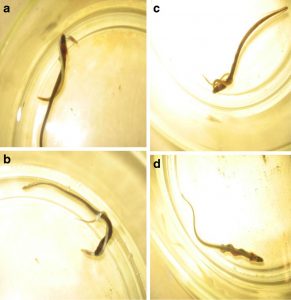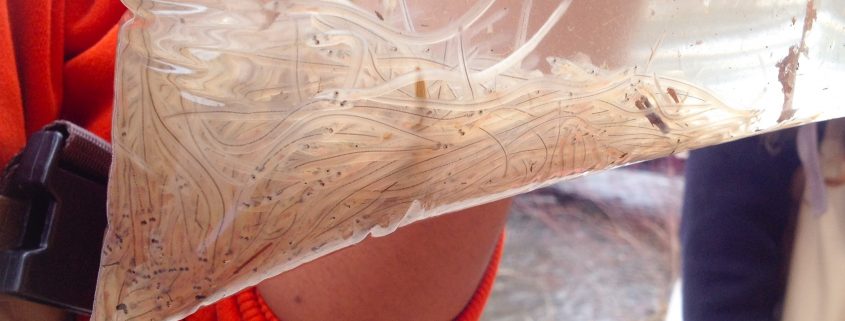Early Life History Predator-Prey Interactions and Habitat Use of the American Eel and American Conger
By Alison Enchelmaier, RJD Graduate Student
Declines in the American eel, Anguilla rostrata, have raised interest in studying the species’ early life history. Potential causes could include overfishing, increased predation, and habitat loss; but determining the cause is difficult due to the American eel’s complex life history. One potential factor, predation, is important to consider as the refuge value of estuarine nursery habitats are being reevaluated (Musumeci et al., 2014).Another factor is habitat competition. American eels arrive in North Atlantic estuaries in their early juvenile stage called glass eels, from the winter to spring. This overlaps with another species called Conger oceanicus. Commonly called the American conger, this species arrives in estuaries in the spring to summer. Considering both species have similar life histories, overlapping arrival to estuaries, and the American conger is a piscavore it is possible that both species compete for habitat space and C. oceanicus may prey on A. rostrata (Musumeci et al., 2014).

Early juvenile stage of eel growth called glass eels. Photo credit: http://www.caryinstitute.org/students/hudson-data-jam-competition/data-jam-data-sets/eels-hudson-river-tributaries-nysdec
Musumeci et al. (2014) examined the habitat use of both American congers and American eels by placing them in bowls containing sand and PVC pipe shelter. Each eel was observed to see how often they buried themselves in the sand, rested on top of the sand, or sheltered in the PVC pipe. American eels spent nearly even time sheltered (39%), buried (30%), and on top of the sand (31%). Alternatively, American congers divided their time lying on top of the sand (52%) and sheltering (48%). No congers buried themselves in the sand (Musumeci et al., 2014). From these observations it appears that there is some overlap in both species habitat use, though only American eels bury themselves.
To examine predator-prey relationships, Musumeci et al. (2014) placed two eels of varying sizes together for 24 hours. Predator-prey pairs were one American conger and one American eel, two American congers, or two American eels. American congers successfully preyed on American eels in 45% of the trials. American congers did not seem to have a size preference, as they preyed on American eels of similar and smaller sizes. American eels did not prey on American congers in any of the trials. When two congers were paired together cannibalism occurred in 16% of the trials, usually when the eels were different sizes. Only 1% (one instance) of American eel trials resulted in cannibalism.

Predator-prey interaction between an American conger (larger, predator) and American eel (smaller, prey). Photo credit: Musumeci et al., 2014)
Interactions between American congers and American eels are likely as they have been collected together for several decades. Both species arrival to estuaries and habitat preferences overlap, which means that they may compete for habitat space and demonstrate predator-prey interactions (Musumeci et al., 2014). Based on predation trials, it appears that American eels are potential prey for American congers, which has not yet been observed in nature. American conger cannibalism was frequent enough to indicate that it may occur in nature, though it has not yet been observed in field. The lack of American eel cannibalism contradicts culture system observations of cannibalism between similarly sized juveniles (Musumeci et al., 2014).American conger predation on American eels may affect the American eel’s survival and habitat use. This new information shows that predation and habitat space competition could play a part in the American eel’s decline.
Reference: Musumeci, V.L., Able, K.W., Sullivan, M.C., & Smith, J.M. (2014). Estuarine predator—prey interactions in the early life history of two eels (Anguilla rostrata and Conger oceanicus). Environmental Biology of Fishes. First published online: 1 November 2013.




Leave a Reply
Want to join the discussion?Feel free to contribute!